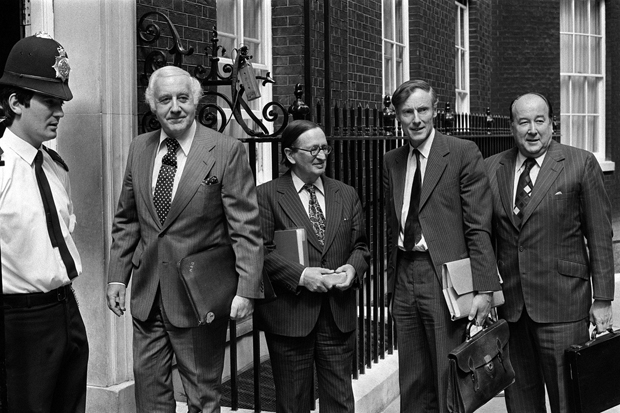Sir Adrian Cadbury, who has died aged 86, is remembered as the author in 1992 of a first stab at a corporate governance code for public companies — which thereafter were expected to show ‘Cadbuarial correctness’ in the separation of chief executive and chairman and the powers of non-executive directors. Cadbury’s work was taken forward by the 1995 Greenbury report, the 1998 Hampel report, the Higgs review in 2003 and a subsequent drawing-together into a ‘Combined Code’. Finally Vince Cable, as business secretary, left his own mark by setting a target of 25 per cent women on FTSE100 boards by this year.
So we now have a fat compendium of boardroom compliance — that has not obviously led to better decision-making, higher ethics or improved shareholder value. Sir Adrian himself, right at the beginning of this process, observed that ‘codes will not catch rogues’, but the weaknesses of the system have proved much broader than that.
A forceful chief executive is rarely reined in by non-executive colleagues, however wise: witness Fred Goodwin’s mad ego-trip at RBS. A distinguished chairman hired in from a different sector is unlikely to be the right front-man for a corporate crisis: witness the dismal debut at BP of Carl-Henric Svanberg, a telecoms man, at the time of the Gulf of Mexico oil spill; or the hapless performance of ex-Treasury mandarin Sir Richard Broadbent in the Tesco chair when the supermarket giant’s accounting scandal broke last year.
The suspicion must be that the Combined Code — and the preceding good intentions of Sir Adrian and others — has turned into an endless boon for headhunters but not for corporate performance. This is not to say we need a different code — but perhaps a more flexible application of the one we’ve got, to allow for variations of experience and circumstance, combined with more interference by institutional investors, who are too reluctant to exercise their power as owners.
In particular, I believe the modern corporate fetish for hiring eye-catching senior executives from outside — supposedly because internal appointments look second-best — is misguided, as well as fuelling an unstoppable and socially offensive pay spiral. Likewise the prejudice against promoting a chief executive to be chairman of the same company. Of course fresh perspective is sometimes essential, but too often what’s lost is deep knowledge, continuity and collegiate trust. Discuss.
Idleness and tight trousers
When I visited Cadburys’ factory at Bourneville a decade ago, Sir Adrian welcomed me as proprietorially as his Victorian forebears might have done — even though the family shareholding had dipped below a majority long ago and latterly shrunk to a tiny slice. The workforce had also shrunk, from 16,000 to just 1,200, many replaced by robots, but strong traces of the Quaker founders’ paternalism survived. As chairman in the 1980s, Sir Adrian had been an earnest moderniser who grappled with the new-fangled science of brand management but strove to preserve the company’s distinctive ethos and keep potential takeover bidders at bay; he was saddened when Cadburys fell to the Kraft Foods conglomerate (now renamed Mondelez) in 2010.
But the tide of corporate change is irresistible. When Kraft ran into flak for closing Cadburys’ Keynsham factory near Bristol — home of Fry’s Turkish Delight — having promised during the bid to keep it open, the irony missed by many objectors was that Sir Adrian’s successors at Cadburys had earlier announced their own plan to close the plant and shift production to Poland. As a final mean twist to that tale, Mondelez has just refused permission for Cadburys’ brands to be used as street names in the housing estate now being built on the site.
A happier turn of events was the 2007 demerger of the Schweppes soft drinks division: it was marriage with the Schweppes company in 1969 that first diluted Cadbury family control, and Sir Adrian liked to quote his grandfather George, builder of Bourneville’s model village, who once penned a pamphlet against the evils of ‘idleness, tight trousers and carbonated beverages’.
The future of the firm
One person who has never shown much interest in corporate correctness is Her Majesty the Queen — but if you had been able to buy shares in 1952 in the royal ‘firm’ of which she has been executive chairman these past 63 and a half years, you would have made out like Warren Buffett. When she succeeded her father, the royal finances were not a matter for public discussion: the first estimate of her private wealth, at £60 million, did not appear in the press until 1969. More recently, a consultancy called Brand Finance came up with a figure of £44 billion as the value of the entire monarchical enterprise, made up of £18 billion of ‘tangible assets’ (a small portion of them privately owned, the rest attached to the job) and £26 billion of ‘intangibles’ representing ‘the value of the uplift to the economy attributable to the monarchy’.
Though any conventional company would have made her retire 20 years ago, there can be no doubt that the Queen has been a brilliant manager of her own brand (only Sir Richard Branson stands comparison) and a sharp-eyed steward of the royal asset portfolio. Comparisons with Sir Terry Leahy’s reign at Tesco, or Lord Browne of Madingley’s heyday as ‘the Sun King of the oil industry’ at BP, are not entirely far-fetched — because the clear problem now is what happens next.
The Prince of Wales’s eccentricities and extravagances have been cushioned all these years by the wealth of the Duchy of Cornwall. His brothers are even less businesslike, and if there were choice in the matter, royal financial advisers would surely be recommending the steely Princess Royal for promotion to the top job. Still, be thankful there‘s no headhunter involved, searching for an eye-catching appointee from outside.







Comments